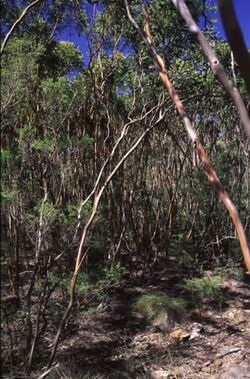Biology:Eucalyptus castrensis
| Singleton mallee | |
|---|---|

| |
| Scientific classification | |
| Kingdom: | Plantae |
| Clade: | Tracheophytes |
| Clade: | Angiosperms |
| Clade: | Eudicots |
| Clade: | Rosids |
| Order: | Myrtales |
| Family: | Myrtaceae |
| Genus: | Eucalyptus |
| Species: | E. castrensis
|
| Binomial name | |
| Eucalyptus castrensis K.D.Hill[1]
| |
Eucalyptus castrensis, commonly known as Singleton mallee[2] or Pokolbin mallee box,[3] is a species of mallee that is endemic to a small area of New South Wales in eastern Australia. It has mostly smooth bark, lance-shaped adult leaves, flower buds in groups of seven, white flowers and cup-shaped fruit.
Description
Eucalyptus castrensis is a mallee that typically grows to a height of 8 metres (26 ft). It has smooth bronze-grey bark but older stems sometimes have a collar of rough bark near the base. Young plants have dull bluish green, egg-shaped to lance-shaped leaves that are 60–115 mm (2–5 in) long and 15–40 mm (0.6–2 in) wide. Adult leaves are glossy green, lance-shaped, 60–130 mm (2–5 in) long, 8–22 mm (0.3–0.9 in) wide on a petiole 4–15 mm (0.2–0.6 in) long. The flower buds are arranged in groups of seven on a peduncle 7–10 mm (0.3–0.4 in) long, the individual buds on a pedicel 1–5 mm (0.039–0.197 in) long. Mature buds are oval, 5–6 mm (0.20–0.24 in) long and 2–4 mm (0.079–0.16 in) wide with a conical operculum. Flowering has been observed in August and the flowers are white. The fruit is a woody, cup-shaped capsule, 4–5 mm (0.16–0.20 in) long and 4–6 mm (0.16–0.24 in) wide with the valves well below the rim.[4][5][6]
Taxonomy and naming
Eucalyptus castrensis was first formally described in 2002 by Ken Hill from a specimen collected on the Singleton Army Base and the description was published in the journal Telopea''.[7] The specific epithet (castrensis) is derived from the Latin word castra meaning "camp"[8]:350 with the suffix -ensis meaning "of" or "from",[8]:38 referring to the occurrence of this eucalypt in the grounds of an army base.[5]
Distribution and habitat
Singleton mallee is only known from a single dense stand on an army base near Singleton where it grows on a low, broad sandstone ridge.[2]
Conservation status
This eucalypt is listed as "endangered" under the New South Wales Government Biodiversity Conservation Act 2016.[2]
References
- ↑ "Eucalyptus castrensis". Australian Plant Census. https://biodiversity.org.au/nsl/services/apc-format/display/178794.
- ↑ 2.0 2.1 2.2 "Singleton mallee - profile". New South Wales Government Office of Environment and Heritage. https://www.environment.nsw.gov.au/threatenedspeciesapp/profile.aspx?id=10928.
- ↑ Bell, Stephen; Rockley, Christine; Llewellyn, Anne (2019). Flora of the Hunter Region : endemic trees and larger shrubs. CSIRO. p. 46. ISBN 9781486311033.
- ↑ Hill, Ken. "Eucalyptus castrensis". Royal Botanic Garden Sydney. http://plantnet.rbgsyd.nsw.gov.au/cgi-bin/NSWfl.pl?page=nswfl&lvl=sp&name=Eucalyptus~castrensis.
- ↑ 5.0 5.1 Hill, Kenneth D.; Stanberg, Leonie C. (2002). "Eucalyptus castrensis (Myrtaceae), a new species from New South Wales". Telopea 9 (4): 773–775. doi:10.7751/telopea20024016.
- ↑ "Eucalyptus castrensis (a tree) - endangered species listing". New South Wales Government Office of Environment and Heritage. https://www.environment.nsw.gov.au/determinations/EucalyptusCastrensisEndSpListing.htm.
- ↑ "Eucalyptus castrensis". APNI. https://id.biodiversity.org.au/instance/apni/581025.
- ↑ 8.0 8.1 Brown, Roland Wilbur (1956). The Composition of Scientific Words. Washington, D.C.: Smithsonian Institution Press.
Wikidata ☰ Q15396208 entry
 |

